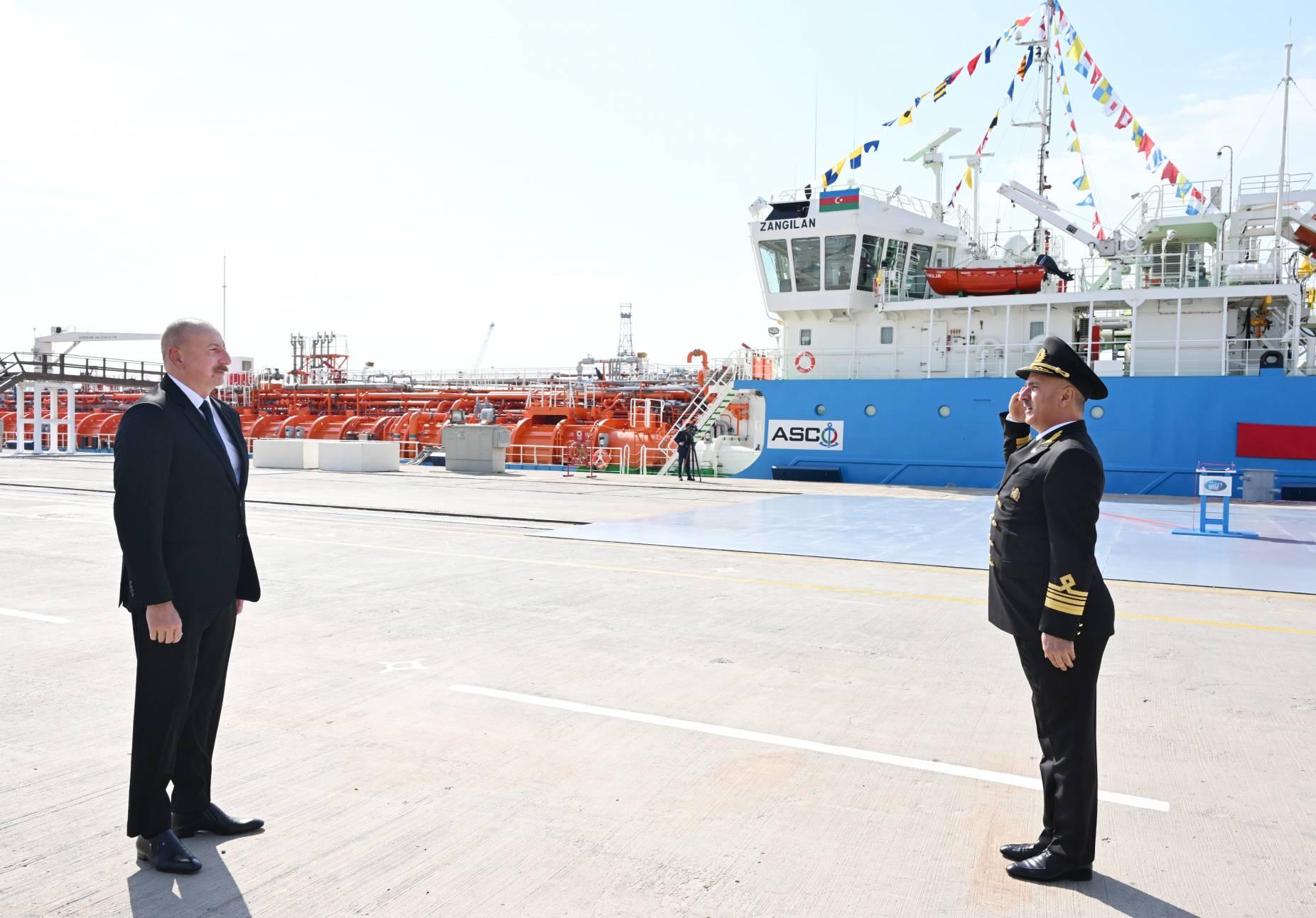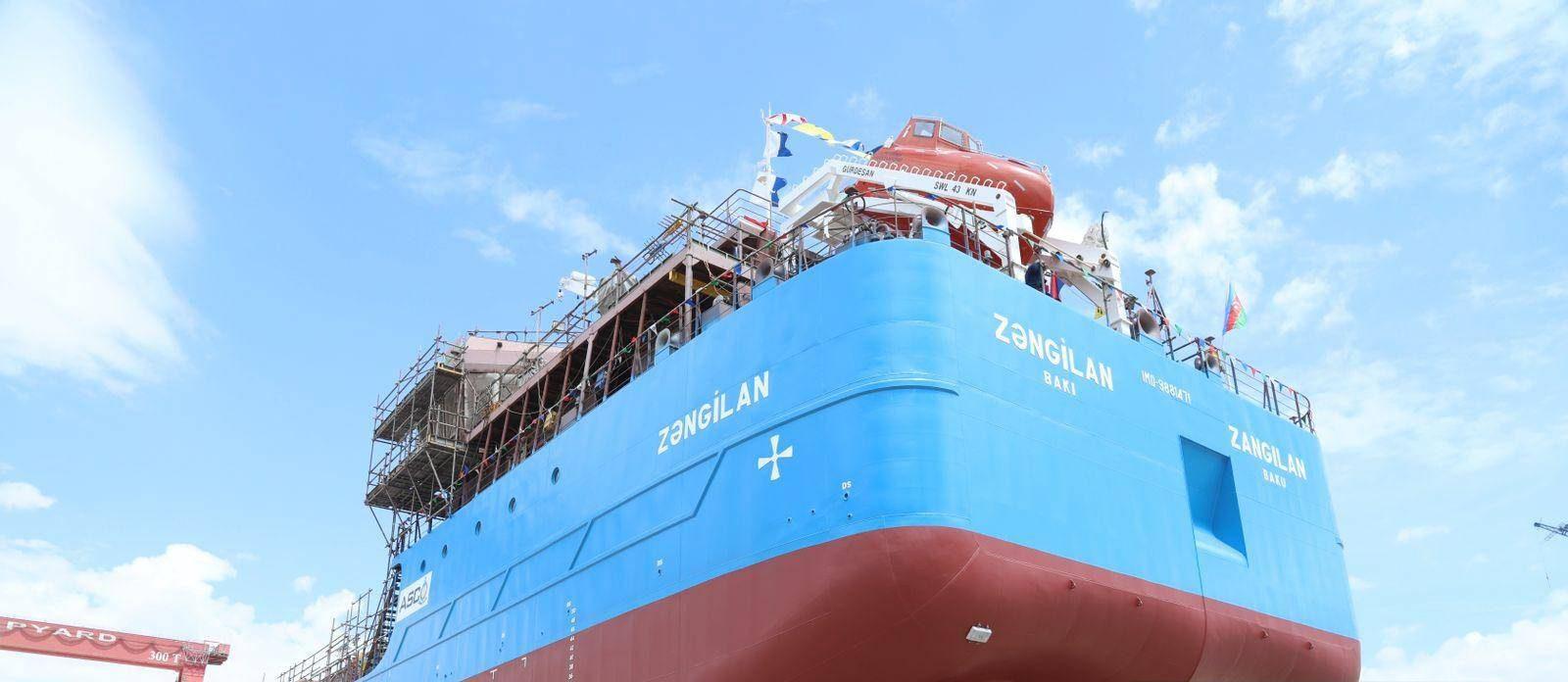Azerbaijan unveils Zangilan tanker to boost Caspian oil transport Caliber.Az review
The increased interest in cargo transit along the Middle Corridor, connecting China and Central Asia with Türkiye and Europe amidst the backdrop of the Russo-Ukrainian war, is also contributing to the expansion of Trans-Caspian oil transit from Kazakhstan and Turkmenistan through Azerbaijan.
Against this positive backdrop, Caspian countries are bolstering their tanker fleets, and constructing new vessels at local shipyards. Leading in this effort is the Baku Shipyard LLC, where orders are being placed by the Azerbaijan Caspian Shipping Company (ASCO) for ferries, bulk carriers, supply vessels, and tankers. Recently, with the participation of Azerbaijani President Ilham Aliyev, a ceremony was held to commission the new tanker “Zangilan” into service.
In recent years, the Baku Shipyard has not experienced a shortage of orders for new tankers, ferries, and vessels of various types. The foundation of this demand lies in the Strategic Plan for Shipping Development for 2022-2030, under which ASCO plans to acquire around fifty vessels, including cargo and passenger ships. Notably, a significant portion of the cargo ships will be built directly in Azerbaijan: ASCO is gradually placing orders at the facilities of Baku Shipyard, and the existence of its own shipyard (established in 2013) has allowed the republic to achieve import substitution with a substantial reduction in production costs. In recent years, Baku Shipyard has constructed one transport vessel (SOCAR-1), three supply-passenger vessels ("Ufug", "Zafar", and "Turan"), three tankers, and two Ro-Pax ferries ("Azerbaijan" and "Zarifa Aliyeva").
Currently, the shipyard's portfolio includes new orders from ASCO for a dozen vessels of various types. Planned constructions include tugboats, cranes of different lifting capacities, a trailing suction hopper dredger CSD 650, and various auxiliary vessels. Notably, on June 14 of this year, ASCO and Baku Shipyard signed a contract for the construction of three diving support vessels designed to operate at depths up to 45 meters, as well as two tankers with a capacity of 8,000 tons each. It is worth mentioning that ASCO's fleet is the largest on the Caspian Sea, comprising 55 vessels of different purposes, including around twenty tankers of varying displacement.

The latest step in the renewal of Caspian Shipping's tanker fleet is the commissioning of the new tanker "Zangilan," which marks the fourth domestically produced oil tanker. During the ceremony, the chairman of ASCO, Rauf Veliev, reported to President Ilham Aliyev that the tanker had been named after the ancestral and eternal Azerbaijani land of Zangilan, liberated by the Azerbaijani army during the 44-day Patriotic War.
The head of state was briefed on the technical specifications of the new oil tanker. The next-generation tanker has a length of 141 meters, a width of 16.9 meters, and a height of 6 meters. It is operated by a crew of 15 and powered by two main engines, each with 1200 kW, capable of reaching a speed of up to 10 knots. The vessel is equipped with 6 cargo tanks totalling 9,212 cubic meters in capacity, with a sea draft of approximately 8,000 tons. It features cargo pumps, ventilation systems, navigation instruments, a separator, and other equipment from leading global manufacturers.

It is worth noting that on the slips of Baku Shipyard in 2019, the first domestically produced tanker "Lachin" with a deadweight of 7,800 tons was built. Following this, in September 2021, the oil tanker "Kalbajar" of similar deadweight was launched. In December 2022, the tanker "Academician Khoshbakht Yusifzade" entered service, equipped with six cargo tanks totalling 9,212 cubic meters in capacity and capable of simultaneously transporting crude oil and various petroleum products.
The newly commissioned tanker of the same series, "Zangilan," like "Academician Khoshbakht Yusifzade," is designed for combined transportation of raw materials, fuel, and other chemical products. It is noteworthy that all these tankers of the Volga-Don MAX project were developed with the assistance of specialists from the Marine Engineering Bureau of Odessa and belong to the river-sea type. This means they can easily navigate through the Volga-Don Canal due to their dimensions and shallow draft, and they can also access shallow-water ports in the Caspian Sea region, even when fully loaded.
The decision of Baku Shipyard and ASCO to focus on low-draft oil tanker projects is a highly forward-thinking choice, given the current challenges and uncertainties regarding the long-term shallowings in the Caspian Sea. Today, there are significant depth problems in the waters and approach channels of marine ports like Olya and Astrakhan in Russia, as well as maritime harbours in Kazakhstan. Specifically, in ports such as Aktau and Kuryk, the average depth is around 4.9 meters compared to the navigational requirement of 6.11 meters. As a result, ships are loaded in Kazakh ports at less than 75% of their available deadweight capacity.
"In the port of Aktau, oil tankers are underloaded due to the decreasing level of the Caspian Sea. Specifically, tankers capable of carrying 12,000 tons of oil are only loaded with 8-8,500 tons. This is the case when they are bound for Makhachkala, where water levels are even lower than ours. If tankers are headed to Baku, they are loaded up to 9,000-9,500 tons," noted recently by Abay Turikpenbayev, the president of the Aktau Sea Commercial Port. "In the event of further shallowing of the Caspian, tanker loads will further decrease, impacting maritime transport economics and leading to increased transport costs," he added.
Thus, Azerbaijan's relevant agencies are pursuing a prudent and forward-thinking policy by assembling less capacious tankers designed for shallower drafts in navigational channels, ideal for operations in Caspian ports. These tankers will easily navigate the Volga-Don Canal and transport cargoes across the Black Sea and other seas with maximum payload capacity when needed.
However, there is plenty of work within the Caspian Basin for domestically built tankers from Baku Shipyard. The driver of shipbuilding activity in the Caspian region was the energy crisis in Europe two years ago, exacerbated by subsequent economic and transport-logistical sanctions from the West, effectively disrupting traditional logistics for oil shipments from Russia to Europe. There remains a high demand for oil, as well as the European Union's needs for fuel and chemical products from Azerbaijan, Kazakhstan, and Turkmenistan, significantly increasing the necessity to expand ASCO's tanker fleet and those of Central Asian countries along the Trans-Caspian route.
In 2023, ASCO transported 4.9 million tons of oil and petroleum products by tankers, a notable increase from previous years. Tanker loading in the first quarter of 2024 continued to grow, with 960,796 tons of liquid hydrocarbons transported. Specifically, the increase in oil transit along the Trans-Caspian route was driven by an agreement signed early last year between NC KazMunayGas and Azerbaijan's State Oil Company (SOCAR). This agreement involves the transportation of over a million tons of Kazakhstani oil through the Baku-Tbilisi-Ceyhan (BTC) pipeline system. Transport began in April last year, with Azerbaijan receiving between 12 and 14 tankers of oil per month, mostly extracted from Kazakhstan's Tengiz field. According to KazTransOil data, a total of 1.392 million tons of oil (from Tengiz and other Kazakhstan production companies) was transited through the BTC in 2023, which is 5.5 times higher than in 2022.

It should be noted that the majority of Kazakhstan's oil has been transported for many years via the Caspian Pipeline Consortium (CPC) pipeline. This pipeline, spanning 1,511 kilometres with a capacity of 67 million tons of crude oil per year, holds immense importance for Kazakhstan. Approximately three-quarters of all Kazakhstani oil exports, primarily from the Tengiz and Kashagan fields, pass through the CPC pipeline to the Novorossiysk marine terminal.
Amidst the Russian-Ukrainian conflict in 2022, Kazakhstan faced challenges in crude oil transit via the CPC pipeline. Astana (now Nur-Sultan) aimed to diversify energy resource transit through regional countries, with Azerbaijan being selected as an optimal alternative route.
In particular, by 2025, KazMunayGas expects to launch a project to expand production at the Tengiz field from approximately 12 million tons of oil per year to around 39 million tons per year. This perspective significantly contributes to the increase in transit volumes through Azerbaijan.
Moreover, in the next two years, oil transit will see a substantial increase: the government of Kazakhstan plans to increase throughput via the Baku-Tbilisi-Ceyhan (BTC) pipeline to 1.5 million tons in 2024 and to 3 million tons in 2025. Alongside expanding Kazakhstani oil transit through the BTC pipeline (from 120,000 tons per month to 180,000 tons), other terminals and transhipment resources are planned to be utilized.
Currently, discussions include the prospects of transporting Kazakhstani oil through the Baku-Supsa pipeline, potentially up to 3 million tons annually or more. All these steps require the involvement of more tankers for transferring new oil volumes across the Caspian Sea. Consequently, new oil tankers are being commissioned in Kazakhstan and actively constructed in Azerbaijan. The introduction of the new tanker "Zangilan" will undoubtedly contribute to these extensive initiatives.








